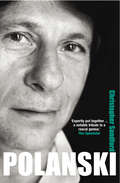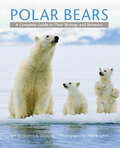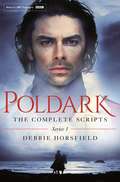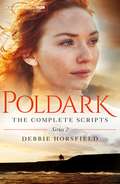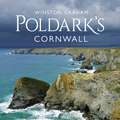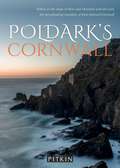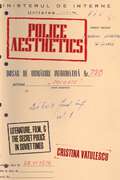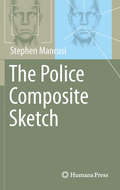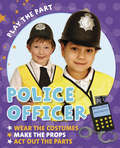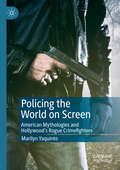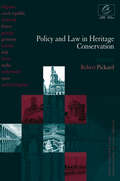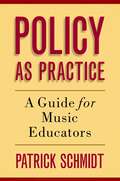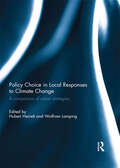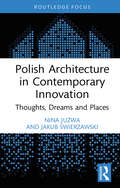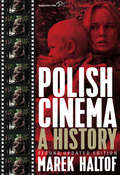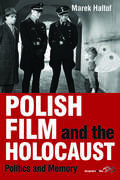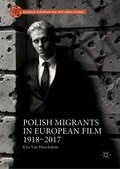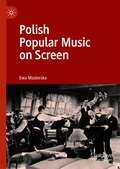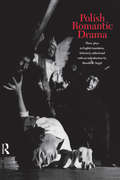- Table View
- List View
Polanski: A Biography
by Christopher SandfordBorn in Paris to Polish-Jewish parents, Polanski dealt with the terrors of his childhood - including internment in Auschwitz - by creating an elaborate fantasy world in which he lived as a film star. He would go on to become one of the very best and most infamous directors in Hollywood's history - with a backlist that includes Repulsion, Rosemary's Baby, Macbeth, Chinatown, Tess, Frantic and, more recently, the Oscar- and Golden Globe-winning The Pianist. Yet, it is within his own personal life that the most dramatic story unfolds - he's been at the centre of two of the most lurid crimes ever committed in Hollywood. In August 1969 his wife Sharon Tate, eight months pregnant, and seven of the couple's friends were butchered by the Manson family; Polanski himself, who was in London at the time, was the intended target. Eight years later he was arrested by LA police on charges of drugging and raping a 13-year old model and aspiring actress He fled the country and has since lived in exile in Paris, where he complains of continual harassment by the US authorities. Polanski's latest film was the hit Oliver Twist and, Variety insists, he promises to follow it with his long-awaited version of the Tate killings. Both projects, dealing with child exploitation and murder, can only fuel the controversy that surrounds him. This biography is the first chance his fans and detractors will have to read about him in real depth. It will reveal the brilliant invention, self-destruction, talent, self-destruction, sex, drugs and wild excesses, with names and stories told for the first time. Fascinating, flawed, wildy creative, this is the full, uncut story of one of the greatest directors of our time.
Polar Bears: A Complete Guide to Their Biology and Behavior (Endangered And Threatened Animals Ser.)
by Andrew E. DerocherThe polar bear, king of the Arctic, is one of the world’s most recognizable animals. Images of the majestic beasts roaming across the ice cap, plunging into frigid waters, and playing with furry cubs have come to symbolize the beauty and grandeur of the Arctic. Andrew E. Derocher and Wayne Lynch have spent decades following the bears, and this book offers the most comprehensive and readable review of their biology, ecology, behavior, and conservation.With gripping photographs by Lynch, a preeminent wildlife photographer, and the personal stories of Derocher, this book is as stunning to look at as it is fascinating to read. It weaves together their remarkable experiences with the latest research to tell the amazing story of these Arctic predators, tracing the animals back to their evolutionary roots and looking ahead to the future of polar bears on a warming planet Earth.Through informative and engaging language, Derocher carefully explains the sea ice ecosystem that is essential to the survival of polar bears. He addresses the threat of global warming to the Arctic—home to polar bears for tens of thousands of years—and describes in impressive detail their feeding habits, distribution, den ecology, and reproduction. Lynch’s vivid photographs capture all this and more as they chronicle the wide range of polar bear behavior, from family rituals to ferocious predatory practices. Captivating, accurate, and inspiring, Polar Bears belongs in the hands of all who love the wild.
Poldark: The Complete Scripts - Series 1
by Debbie HorsfieldCornwall, 1783. The American Revolutionary War is over. Cornishman Ross Poldark returns to his father's lands a battle-weary soul. Met by a homeland gripped in recession and the revelation of his father's death, Ross must contend with the disrepair of his property and the challenge of keeping his family tin mine in business as his sweetheart prepares to marry his cousin. Amidst the stark beauty of the Cornish landscape, Ross must fight for his livelihood, making allies, and enemies, along the way.Delve deeper into the hit BBC drama starring Aidan Turner as Ross Poldark and Eleanor Tomlinson as Demelza. Collecting together Debbie Horsfield's original scripts, Poldark: The Complete Scripts - Series 1 allows you to relive the greatest moments from the first series, from Poldark's initial homecoming to the series' dramatic close. This is the perfect accompaniment for fans of the series and gives a unique insight into how the show was visualized.
Poldark: The Complete Scripts - Series 2
by Debbie HorsfieldCornwall, 1790. Ross Poldark faces the darkest hour of his life. Accused of wrecking two ships, he is to stand trial at the Bodmin Assizes. Despite their stormy married life, Demelza has tried to rally support for her husband. But there are plenty of enemies who would be happy to see Ross convicted, not least the powerful banker George Warleggan, whose personal rivalry with Ross grows ever more intense.This second volume of Debbie Horsfield's original scripts for the acclaimed television series takes readers from Ross's trial to the dramatic final episode. Poldark: The Complete Scripts - Series 2 is the perfect companion to the television series starring Aidan Turner, and affords a fascinating insight into how Winston Graham's beloved novels are transformed for the screen.
Poldark's Cornwall: A Novel Of Cornwall 1812-1813 (Poldark Ser. #9)
by Winston GrahamA lavishly illustrated companion to Winston Graham's beloved Poldark novels, reissued to coincide with the BBC series based on the novels. Graham's saga of Cornish life in the eighteenth century has enthralled readers throughout the world for seventy years and the wild landscapes that inspired the novels have - even today - remained relatively unchanged. Cornwall then was a perilous world of pirates and shipwrecks: of rugged coast and mysterious smugglers' coves, of windswept moors and picturesque villages such as Boscastle and Port Quin, and of beaches, tin mines and churches. With an introduction by Winston Graham's son, Andrew, and illustrated with stunning photographs, Poldark's Cornwall is a glorious evocation of the land of beauty, excitement, romance and imagination that Graham loved so well.
Poldark's Cornwall (Location Guides #5)
by Gill KnappettAre you longing to know where your favourite scenes in Poldark were filmed? Or discover the secrets behind the derelict mines and perfect, unspoiled beaches? Pitkin's latest addition to the Film Locations series allows you the inside knowledge to go behind the scenes and follow in the footsteps of Ross and Demelza. Travel back in time and join them along the windswept cliffs, rugged coastline and untouched, pristine beaches. From Padstow to the Lizard peninsula, Cornwall takes centre stage, providing the breath-taking backdrop that brings the series to life. The latest awarding-winning adaptation of Winston Graham's Poldark, produced by the BBC, has captured the hearts of millions of viewers worldwide. As the third series returns to our screens this summer, and with a forth series underway, tourists from all over the globe are flocking to the deepest corners of the UK's southwestern tip. Over the last three years the series has brought the region's rich heritage back to life, with tales of smugglers, shipwrecks and the secrets of the mines gripping viewer's imaginations. Visit the Poldark family mines at Agnes Head or Levant Mine, a World Heritage Site. Gallop along the clifftops of Chapel Porth, and learn of famous shipwrecks at Gunwalloe. If it's the glistening, azur waters you're after, don't miss Holywell Bay, Cornwall's largest stretch of coastline, which becomes the Warleggans private beach in series two. Cornwall has been an inspiration for writer's, film directors and artists alike for centuries, and Eleanor Tomlinson (Demelza) sums up its magic. "So much of the piece came alive when we were filming in Cornwall and everyone found their character in the outdoors." Britain's best kept secret is yours to enjoy.
Police Aesthetics: Literature, Film, and the Secret Police in Soviet Times
by Cristina VatulescuThe documents emerging from the secret police archives of the former Soviet bloc have caused scandal after scandal, compromising revered cultural figures and abruptly ending political careers. Police Aesthetics offers a revealing and responsible approach to such materials. Taking advantage of the partial opening of the secret police archives in Russia and Romania, Vatulescu focuses on their most infamous holdings—the personal files—as well as on movies the police sponsored, scripted, or authored. Through the archives, she gains new insights into the writing of literature and raises new questions about the ethics of reading. She shows how police files and films influenced literature and cinema, from autobiographies to novels, from high-culture classics to avant-garde experiments and popular blockbusters. In so doing, she opens a fresh chapter in the heated debate about the relationship between culture and politics in twentieth-century police states.
The Police Composite Sketch
by Stephen MancusiThe police composite sketch, one of the most crucial investigative tools in law enforcement, is developed during a composite session—an intense display of communication and art in which the words of a witness are transformed into the features of a suspect. Despite the incredible technological leaps made in investigative work, the forensic science of composite sketching still relies on the basic elements of drawing skill, interpretive ability and the spoken word. The Police Composite Sketch is a comprehensive manual on how to conduct a complete composite session. Through an array of case studies, it details several disciplines that comprise this specialized forensic art, including composite sketching, image modification, age progression, facial comparison analysis, demonstrative evidence and postmortem/skull reconstruction. It also explores how to intuit insights that are often inadvertently revealed by witnesses, victims and perpetrators during the composite session. In addition, this book discusses other relevant topics, such as the three-stage drawing technique, witness and victim types, descriptive terminologies, managing composite sessions. Complete with numerous illustrations and drawing tips, this seminal work offers a general composite session philosophy and specific session strategies to both experienced and aspiring forensic artists as well as any lay reader intrigued by this fascinating skill.
Police Officer: Police Officer Library Ebook (Play the Part)
by Liz GogerlyFind out what a police officer does. Follow step-up-step activities to make a police station front desk, a uniform and a police car. Then follow simple role plays to act out the part of a police officer!
Policing the World on Screen: American Mythologies and Hollywood's Rogue Crimefighters
by Marilyn YaquintoThis book analyzes Hollywood storytelling that features an American crimefighter—whether cop, detective, or agent—who must safeguard society and the nation by any means necessary. That often means going “rogue” and breaking the rules, even deploying ugly violence, but excused as self-defense or to serve the greater good. This ends-justifies-means approach dates back to gunfighters taming the western frontier to urban cowboy cops battling urban savagery—first personified by “Dirty” Harry Callahan—and later dispatched in global interventions to vanquish threats to national security. America as the world’s “policeman often means controlling the Other at home and abroad, which also extends American hegemony from the Cold War through the War on Terror. This book also examines pioneering portrayals by males of color and female crimefighters to embody such a social or national defender, which are frustrated by their existence as threats the white knight exists to defeat.
Policy and Law in Heritage Conservation
by Robert PickardThis book has been developed in association with the Cultural Heritage Department of the Council of Europe. It examines key themes and objectives for the protection of the architectural and archaeological heritage in a range of European countries. The analysis of individual countries and the group as a whole gives an assessment of how advanced current mechanisms are and the ongoing problems that remain to be managed in order to safeguard the 'common heritage'.
Policy and Law in Heritage Conservation (Conservation Of The European Built Heritage Ser.)
by Robert PickardThis book has been developed in association with the Cultural Heritage Department of the Council of Europe. It examines key themes and objectives for the protection of the architectural and archaeological heritage in a range of European countries. The analysis of individual countries and the group as a whole gives an assessment of how advanced current mechanisms are and the ongoing problems that remain to be managed in order to safeguard the 'common heritage'.
Policy as Practice: A Guide for Music Educators
by Patrick SchmidtBoth in concept and in practice, policy has permeated the deepest recesses of civil society and has had particular impact on the lives of those who are actively connected to the educational process. For music teachers in particular, policy can evoke images of a forbidden environment beyond one's day-to-day duties and responsibilities. Nothing, however, could be farther from the truth. In this book, author Patrick Schmidt offers a variety of ways for K-12 music educators to engage with, analyze, and develop effective policy. Schmidt first demystifies the notion of policy and the characterization that it is out-of-reach to teachers, before exemplifying how policy, both big-picture policy and policy as a daily encounter enacted at the local level, share many similarities and are indeed co-dependent fragments of the same process. The first provides extensive and detailed contextual information, offering a conceptual vision for how to consider policy in the fast-pace and high-adaptability reality of 21st-century music education environments. The second delivers a practical set of ideas, guidelines, and suggestions specific to music education for a closer and more active interaction with policy, directed at providing 'tools for action' in the daily working lives of music educators. This approach enourages those who are novice to policy as well as those who would like to further explore and participate in policy action to exercise informed influence within their field, community, and school, and ultimately have greater impact in pedagogical, curricular, administrative, and legislative decision-making.
POLICY AS PRACTICE C: A Guide for Music Educators
by Patrick SchmidtBoth in concept and in practice, policy has permeated the deepest recesses of civil society and has had particular impact on the lives of those who are actively connected to the educational process. For music teachers in particular, policy can evoke images of a forbidden environment beyond one's day-to-day duties and responsibilities. Nothing, however, could be farther from the truth. In this book, author Patrick Schmidt offers a variety of ways for K-12 music educators to engage with, analyze, and develop effective policy. Schmidt first demystifies the notion of policy and the characterization that it is out-of-reach to teachers, before exemplifying how policy, both big-picture policy and policy as a daily encounter enacted at the local level, share many similarities and are indeed co-dependent fragments of the same process. The first provides extensive and detailed contextual information, offering a conceptual vision for how to consider policy in the fast-pace and high-adaptability reality of 21st-century music education environments. The second delivers a practical set of ideas, guidelines, and suggestions specific to music education for a closer and more active interaction with policy, directed at providing 'tools for action' in the daily working lives of music educators. This approach enourages those who are novice to policy as well as those who would like to further explore and participate in policy action to exercise informed influence within their field, community, and school, and ultimately have greater impact in pedagogical, curricular, administrative, and legislative decision-making.
Policy Choice in Local Responses to Climate Change: A Comparison of Urban Strategies
by Hubert Heinelt Wolfram LampingSince the 1990s ‘beliefs’, ‘ideas’ or ‘knowledge’ as well as processes of communicative interactions such as persuasion, argumentation and learning have received increasing attention in social science for the understanding of political changes. This book makes a significant contribution to this scholarly debate and will be of interest to practitioners, showing on one side how climate change has received more and more attention in policy making at the local level and changed the urban agenda and on the other how different the responses of cities to this global challenge are – and how these differences between cities can be explained. This book was previously published as a special issue of Urban Research and Practice.
Policy Choice in Local Responses to Climate Change: A Comparison of Urban Strategies
by Hubert Heinelt and Wolfram LampingSince the 1990s ‘beliefs’, ‘ideas’ or ‘knowledge’ as well as processes of communicative interactions such as persuasion, argumentation and learning have received increasing attention in social science for the understanding of political changes. This book makes a significant contribution to this scholarly debate and will be of interest to practitioners, showing on one side how climate change has received more and more attention in policy making at the local level and changed the urban agenda and on the other how different the responses of cities to this global challenge are – and how these differences between cities can be explained. This book was previously published as a special issue of Urban Research and Practice.
Polish Architecture in Contemporary Innovation: Thoughts, Dreams and Places
by Nina Juzwa Jakub ŚwierzawskiAuthored by two architects, Polish Architecture in Contemporary Innovation: Thoughts, Dreams and Places tells a story of buildings that were built in Poland between 1980 and 2020, as architecture developed in the Western world and Japan. Its main focus is public utility buildings which the authors “have touched” in situ and which have moved them or sparked their interest. The book is divided into three parts: • Part I focuses on the problem of creating and shaping architectural form and uses examples of both international and Polish architecture. In this section, the authors pose the question: why is the Pritzker Prize so important? • Part II attempts to answer the question of how architecture can change the image of a place. The answer consists of mainly Polish examples of user-friendly architecture, value, and beauty in architecture and place. • Part III analyses buildings that were created in contemporary Poland. Examples are listed in groups, according to their function, pointing out forms that were inspired by the culture of the region, the historical culture of the place, or those which are a new quality and are the foundation of the creation of a place. This book aims to demonstrate Polish architectural solutions in the context of contemporary trends in the West, traditionally seen as more technically and technologically developed countries. The floor plans and sections of the buildings presented in the book show the beauty of geometric and formal solutions and give a new and rare perspective on the latest changes in modern Polish architecture. This book will be of interest to architects as well as researchers and students of contemporary Polish architecture and culture and its place in the European and international context. The Polish edition of this book, published in 2021 by the National Institute of Architecture and Urban Planning in Warsaw, received the Vitruvius Prize 2022 by the Architecture and Urban Planning Committee of the Polish Academy of Sciences.
Polish Architecture in Contemporary Innovation: Thoughts, Dreams and Places
by Nina Juzwa Jakub ŚwierzawskiAuthored by two architects, Polish Architecture in Contemporary Innovation: Thoughts, Dreams and Places tells a story of buildings that were built in Poland between 1980 and 2020, as architecture developed in the Western world and Japan. Its main focus is public utility buildings which the authors “have touched” in situ and which have moved them or sparked their interest. The book is divided into three parts: • Part I focuses on the problem of creating and shaping architectural form and uses examples of both international and Polish architecture. In this section, the authors pose the question: why is the Pritzker Prize so important? • Part II attempts to answer the question of how architecture can change the image of a place. The answer consists of mainly Polish examples of user-friendly architecture, value, and beauty in architecture and place. • Part III analyses buildings that were created in contemporary Poland. Examples are listed in groups, according to their function, pointing out forms that were inspired by the culture of the region, the historical culture of the place, or those which are a new quality and are the foundation of the creation of a place. This book aims to demonstrate Polish architectural solutions in the context of contemporary trends in the West, traditionally seen as more technically and technologically developed countries. The floor plans and sections of the buildings presented in the book show the beauty of geometric and formal solutions and give a new and rare perspective on the latest changes in modern Polish architecture. This book will be of interest to architects as well as researchers and students of contemporary Polish architecture and culture and its place in the European and international context. The Polish edition of this book, published in 2021 by the National Institute of Architecture and Urban Planning in Warsaw, received the Vitruvius Prize 2022 by the Architecture and Urban Planning Committee of the Polish Academy of Sciences.
Polish Cinema: A History
by Marek HaltofFirst published in 2002, Marek Haltof’s seminal volume was the first comprehensive English-language study of Polish cinema, providing a much-needed survey of one of Europe’s most distinguished—yet unjustly neglected—film cultures. Since then, seismic changes have reshaped Polish society, European politics, and the global film industry. This thoroughly revised and updated edition takes stock of these dramatic shifts to provide an essential account of Polish cinema from the nineteenth century to today, covering such renowned figures as Kieślowski, Skolimowski, and Wajda along with vastly expanded coverage of documentaries, animation, and television, all set against the backdrop of an ever-more transnational film culture.
Polish Cinema: A History
by Marek HaltofFirst published in 2002, Marek Haltof’s seminal volume was the first comprehensive English-language study of Polish cinema, providing a much-needed survey of one of Europe’s most distinguished—yet unjustly neglected—film cultures. Since then, seismic changes have reshaped Polish society, European politics, and the global film industry. This thoroughly revised and updated edition takes stock of these dramatic shifts to provide an essential account of Polish cinema from the nineteenth century to today, covering such renowned figures as Kieślowski, Skolimowski, and Wajda along with vastly expanded coverage of documentaries, animation, and television, all set against the backdrop of an ever-more transnational film culture.
Polish Film and the Holocaust: Politics and Memory
by Marek HaltofDuring World War II Poland lost more than six million people, including about three million Polish Jews who perished in the ghettos and extermination camps built by Nazi Germany in occupied Polish territories. This book is the first to address the representation of the Holocaust in Polish film and does so through a detailed treatment of several films, which the author frames in relation to the political, ideological, and cultural contexts of the times in which they were created. Following the chronological development of Polish Holocaust films, the book begins with two early classics: Wanda Jakubowska’s The Last Stage (1948) and Aleksander Ford’s Border Street (1949), and next explores the Polish School period, represented by Andrzej Wajda’s A Generation (1955) and Andrzej Munk’s The Passenger (1963). Between 1965 and 1980 there was an “organized silence” regarding sensitive Polish-Jewish relations resulting in only a few relevant films until the return of democracy in 1989 when an increasing number were made, among them Krzysztof Kieślowski’s Decalogue 8 (1988), Andrzej Wajda’s Korczak (1990), Jan Jakub Kolski’s Keep Away from the Window (2000), and Roman Polański’s The Pianist (2002). An important contribution to film studies, this book has wider relevance in addressing the issue of Poland’s national memory.
Polish Migrants in European Film 1918–2017 (Palgrave European Film and Media Studies)
by Kris Van HeuckelomThis study explores the representation of international migration on screen and how it has gained prominence and salience in European filmmaking over the past 100 years. Using Polish migration as a key example due to its long-standing cultural resonance across the continent, this book moves beyond a director-oriented approach and beyond the dominant focus on postcolonial migrant cinemas. It succeeds in being both transnational and longitudinal by including a diverse corpus of more than 150 films from some twenty different countries, of which Roman Polański’s The Tenant, Jean-Luc Godard’s Passion and Krzysztof Kieślowski’s Trois couleurs: Blanc are the best-known examples. Engaging with contemporary debates on modernisation and Europeanisation, the author proposes the notion of “close Otherness” to delineate the liminal position of fictional characters with a Polish background. Polish Migrants in European Film 1918-2017 takes the reader through a wide range of genres, from interwar musicals to Cold War defection films; from communist-era exile right up to the contemporary moment. It is suitable for scholars interested in European or Slavic studies, as well as anyone who is interested in topics such as identity construction, ethnic representation, East-West cultural exchanges and transnationalism.
Polish Popular Music on Screen
by Ewa MazierskaThis book examines the interface between Polish popular music and screen media against the background of Polish history, cinema, and popular culture and situates that interface in a local as well as global context. It looks at Polish musicals, biographical films about musicians, documentary films and, finally, music videos. The author draws attention to the immense popularity of musical comedies in Polish interwar cinema, the enduring appeal of musical genres during the period of state socialism, despite their low status in film criticism, and the re-birth of musicals in the 2010s. Mazierska also discusses the most important stars, directors and authors of songs presented in Polish films, and points to the effect of technological changes on inception and transformation of music-centred genres of screen media, including the effect of YouTube on their growth and preservation. The book is informed by the question of how parochial and universal is Polish popular music and its screen representation.
Polish Romantic Drama: Three Plays in English Translation (Polish Theatre Archives Ser. #Vol. 5)
by Harold B. SegelThis is the first volume in English to be devoted entirely to Polish Romantic drama. It contains translations of three major plays: Forefathers; Eve, Part III, by Adam Mickiewics; The Un-Divine Comedy by Zygmunt Krasinski; and Fantazy by Juliusz Slowacki. In his highly informative introduction, Professor Segel discusses the plays against the background of the Romantic movement in Poland and points out their ideological and artistic importance. As products of a revolutionary Poland; they were written and published in Paris by writers who either resettled there after the Insurrection of 1830 or otherwise identified with the Great Emigration; they are permeated with the spirit of Romantic Rebellion, with pleas for universial justice, and with queries concerning the role of the poet in society. Brillant productions of the plays in Poland in the late nineteenth and early twentieth-centuries gave impetus to an entire tradition of modern Polish theatrical experimentation as well as dramatic writing which extends to the present day.
Polish Romantic Drama: Three Plays in English Translation
by Harold B. SegelThis is the first volume in English to be devoted entirely to Polish Romantic drama. It contains translations of three major plays: Forefathers; Eve, Part III, by Adam Mickiewics; The Un-Divine Comedy by Zygmunt Krasinski; and Fantazy by Juliusz Slowacki. In his highly informative introduction, Professor Segel discusses the plays against the background of the Romantic movement in Poland and points out their ideological and artistic importance. As products of a revolutionary Poland; they were written and published in Paris by writers who either resettled there after the Insurrection of 1830 or otherwise identified with the Great Emigration; they are permeated with the spirit of Romantic Rebellion, with pleas for universial justice, and with queries concerning the role of the poet in society. Brillant productions of the plays in Poland in the late nineteenth and early twentieth-centuries gave impetus to an entire tradition of modern Polish theatrical experimentation as well as dramatic writing which extends to the present day.
